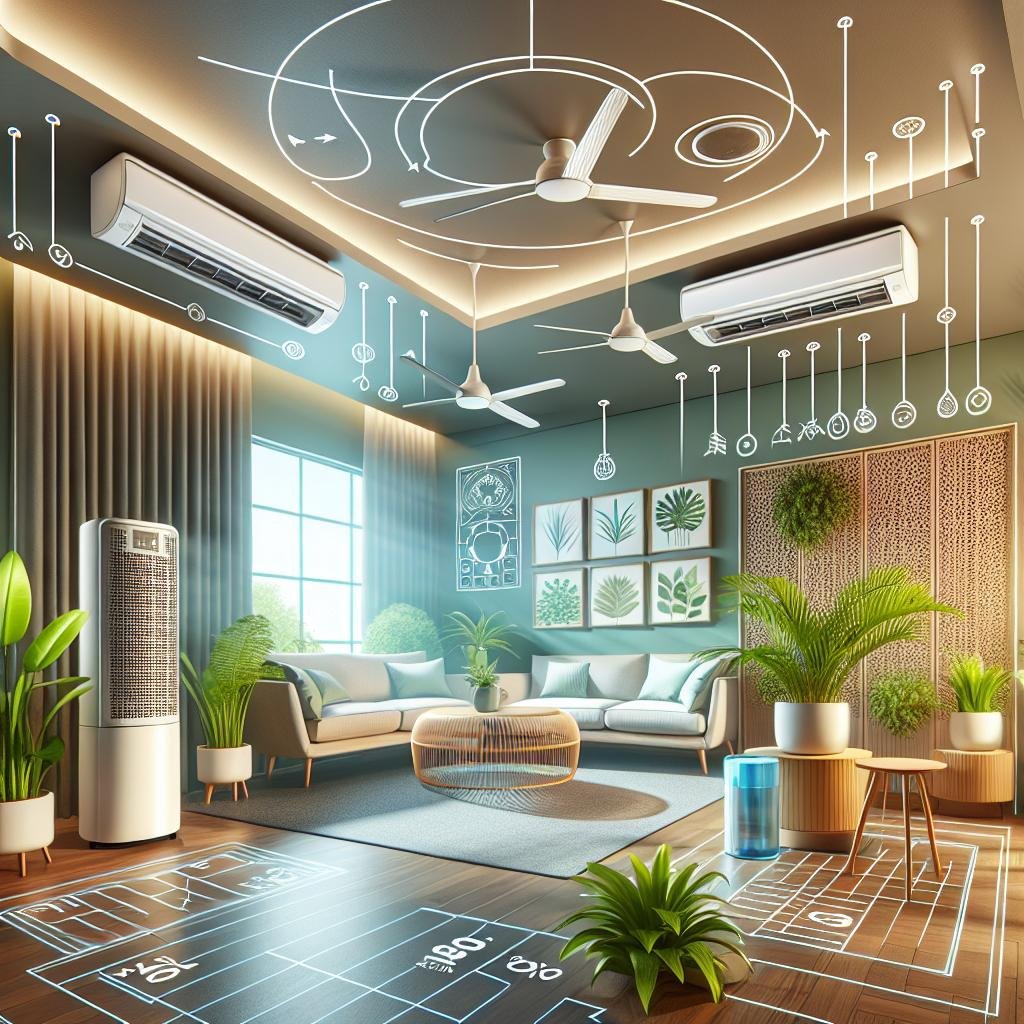As the summer sun blazes down and the air swells with humidity, the quest for comfort can feel like navigating a steamy labyrinth. For many, mini-split air conditioning systems have become the trusty sidekick in this battle against the heat. Compact, versatile, and efficient, these systems not only cool but also help dehumidify the air, making them ideal for regions where humidity reigns supreme. However, like any hero, they need a little guidance to unleash their full potential. In this article, we’ll explore the art of maintaining efficiency in mini-split AC systems when faced with the challenge of high humidity. With a sprinkle of practical tips and a dash of friendly advice, you’ll be equipped to turn your indoor oasis into a breath of fresh air, even on the most sweltering days. So grab a cool drink, kick back, and let’s dive into the world of mini-splits and humidity management!
Understanding Mini Split AC Systems and Their Role in Humidity Management
Mini split AC systems are a popular choice for climate control, especially in areas experiencing high humidity. These systems consist of an outdoor compressor and one or more indoor units, allowing for targeted cooling without the extensive ductwork associated with traditional HVAC systems. One of their primary advantages is their ability to effectively reduce indoor humidity levels. When the air is cooled, it can hold less moisture, leading to condensation that is drained away, thus aiding in maintaining a comfortable indoor environment. This humidity management feature not only enhances comfort but also protects your property from the negative impacts of excessive moisture, such as mold growth.
To maximize the efficiency of mini split AC systems in humid environments, it’s essential to understand how to utilize their features effectively. Here are some key tips for optimal performance:
- Set the right temperature: Aim for a balance that cools effectively but does not overwork the system.
- Regular maintenance: Clean filters and ensure proper drainage to improve efficiency.
- Use the dry mode: This setting can help specifically target and reduce humidity levels without overcooling.
| Humidity Level | Recommended AC Setting |
|---|---|
| Below 50% | Normal Cooling Mode |
| 50% – 60% | Dry Mode for Dehumidification |
| Above 60% | Combine Dry Mode with Normal Cooling |

Tips for Optimal Installation and Placement in Humid Spaces
Achieving optimal performance for your mini split AC system in humid spaces requires careful attention to installation and placement. Start by ensuring that the indoor unit is installed at least 6 to 8 inches away from the ceiling. This distance promotes sufficient airflow circulation, allowing the system to efficiently remove moisture from the air. Additionally, consider placing the unit away from corners and obstructions to minimize airflow restrictions. Using wall brackets can also help elevate the unit, preventing damage from any potential flooding or water accumulation.
Next, it’s essential to focus on the drainage system. Ensure that the condensate drain line is free of clogs and installed at a slight downward slope for optimal drainage. A well-functioning drain line prevents water buildup, reducing the risk of mold growth—an all-too-common concern in high-humidity areas. Lastly, regular maintenance is key; schedule periodic inspections and cleanings to keep the system running smoothly. Consider using a dehumidistat to complement your mini split, allowing you to maintain ideal humidity levels effortlessly.
| Installation Tips | Benefits |
|---|---|
| Place unit away from obstructions | Enhances airflow and efficiency |
| Install at least 6-8 inches from the ceiling | Promotes better moisture removal |
| Ensure proper drainage slope | Prevents water damage and mold |
| Consider a dehumidistat | Helps maintain comfortable humidity |

Mastering Temperature Settings for Peak Performance
When it comes to optimizing your mini split AC system in high-humidity environments, understanding how to use temperature settings effectively can make a significant difference in maintaining comfort and efficiency. Cooler and consistent temperatures can help not only to combat the muggy air but also to prevent the system from overworking. Setting your thermostat too low can lead to increased energy costs and stress on your unit. Instead, aim for a balanced temperature setting around 72°F to 75°F, which is generally effective in achieving a comfortable indoor climate while keeping energy consumption in check.
In addition to temperature, the fan speed settings play a crucial role in humidity management. Utilizing a higher fan speed can improve air circulation, allowing for better humidity control and a more refreshing atmosphere. Make use of features like dehumidification mode, which many mini split systems offer. This setting reduces moisture without excessively cooling the space, making it an optimal choice for those particularly sticky summer days. Consider keeping a thermohygrometer handy to monitor both temperature and humidity levels, ensuring your environment remains at its most comfortable.

Regular Maintenance Practices to Enhance Efficiency and Longevity
To ensure that your mini split AC system not only performs optimally but also enjoys a prolonged lifespan, adhering to a set of maintenance practices is essential. Start with routine filter checks and replacements every month. Dirty filters can drastically impede airflow and efficiency, particularly in high-humidity settings. Additionally, it’s wise to inspect the outdoor unit periodically, keeping it free from debris such as leaves and branches. Using a gentle hose spray, you can rinse away dirt that accumulates on the fins, ensuring uninterrupted airflow and cooling capacity.
Humidity can take a toll on mini splits, so it’s wise to focus on the condensate drain line. Regularly flushing the drain line with a mixture of vinegar can prevent clogs and promote effective moisture removal. Another tip is to check refrigerant levels, as low levels can lead to inefficient cooling and increased energy consumption. A small table below provides a quick checklist for maintaining your system:
| Task | Frequency | Notes |
|---|---|---|
| Filter Check and Replacement | Monthly | Replace if dirty |
| Outdoor Unit Inspection | Monthly | Remove debris around the unit |
| Drain Line Flushing | Every 3 months | Use a vinegar mixture to prevent clogs |
| Refrigerant Level Check | Annually | Consult a professional if low |
Q&A
Q&A: Maintaining Efficiency When Using Mini Split AC Systems in High-Humidity Environments
Q: What exactly is a mini split AC system, and how does it work?
A: Great question! A mini split AC system is a type of heating and cooling system that’s perfect for efficiently managing indoor temperatures. It consists of two main components: an outdoor compressor and one or more indoor air-handling units. These systems work by moving refrigerant between the indoor and outdoor units, allowing for precise temperature control while avoiding the need for ductwork. They’re like having a little climate paradise in each room!
Q: Why is it particularly important to maintain efficiency in high-humidity environments?
A: In high-humidity areas, the air tends to feel warmer than it actually is, and excess moisture can make our indoor spaces uncomfortable. Mini split AC systems help dehumidify the air by removing moisture while cooling it down. Keeping these systems efficient not only enhances comfort but also reduces energy consumption, which leads to lower utility bills—a win-win for both you and Mother Earth!
Q: What are some tips for maintaining my mini split AC in humid conditions?
A: You’re in for a treat! Here are some friendly tips to keep your mini split working efficiently in those sticky situations:
- Regularly Clean Filters: Dust and debris can clog filters, reducing airflow. Clean or replace them every month during peak use!
- Set the Right Mode: Use the ‘dry’ mode during very humid days. This will maximize dehumidification while keeping temperatures comfortable.
- Insulate Properly: Ensure windows and doors are properly sealed. This keeps the cool air in and prevents humidity from sneaking in.
- Use Ceiling Fans: They work hand-in-hand with your mini split, ensuring even distribution of air and helping to cool you down naturally.
- Schedule Maintenance: Annual check-ups from a professional can keep your system running smoothly. They can spot issues like refrigerant leaks or drain problems before they worsen.
Q: How can I tell if my mini split is not performing efficiently?
A: Ah, the telltale signs! If you notice your system running constantly, struggling to reach the desired temperature, or if you see water pooling around the unit, it might be time to investigate. Additionally, odd noises or a musty smell can signal that something isn’t quite right. Don’t ignore these clues—your comfort is worth it!
Q: Can using a mini split AC improve indoor air quality, especially in humid areas?
A: Absolutely! Mini split systems come equipped with filters that can trap dust, pollen, and other allergens. By reducing humidity levels, they also help prevent mold growth, which can be a common concern in humid environments. A cleaner, fresher indoor atmosphere means happier, healthier living!
Q: Are there any eco-friendly tips for using mini split AC systems efficiently?
A: You bet! Embracing a greener lifestyle is easier than ever with these tips:
- Use a Programmable Thermostat: This allows you to set specific cooling times, saving energy when you’re not home.
- Optimize Your Landscaping: Shade your outdoor units with trees or shrubs, helping them run cooler and more efficiently.
- Choose Energy-Efficient Models: When upgrading, look for models with the ENERGY STAR® label; they are more efficient and environmentally friendly!
Q: Final thoughts or pro advice for mini split users in humid areas?
A: Just remember, every little bit counts! By being proactive and attentive to your mini split’s needs, you’ll not only ensure a comfortable living space but also extend the life of your system. Celebrate small victories like clearing those filters or adjusting your settings—your future self (and your wallet) will thank you! Happy cooling!
Concluding Remarks
As we wrap up our exploration of maintaining efficiency with mini split AC systems in the balmy embrace of high-humidity environments, it’s clear that a little know-how goes a long way. By understanding the unique challenges posed by moisture and temperature, you can transform your living space into a cozy haven, no matter how sticky the weather gets outside.
Remember, it’s not just about cooling your home; it’s about creating an oasis of comfort and well-being. Regular maintenance, strategic settings, and smart placements will not only enhance the performance of your mini split system but also keep those pesky humidity levels in check.
So, roll up those sleeves, embrace the art of HVAC care, and enjoy the refreshing comfort that comes from a well-managed air conditioning system. Here’s to enjoying those humid days with a cool breeze at your back—no sweat, just sweet relief! Happy cooling!

